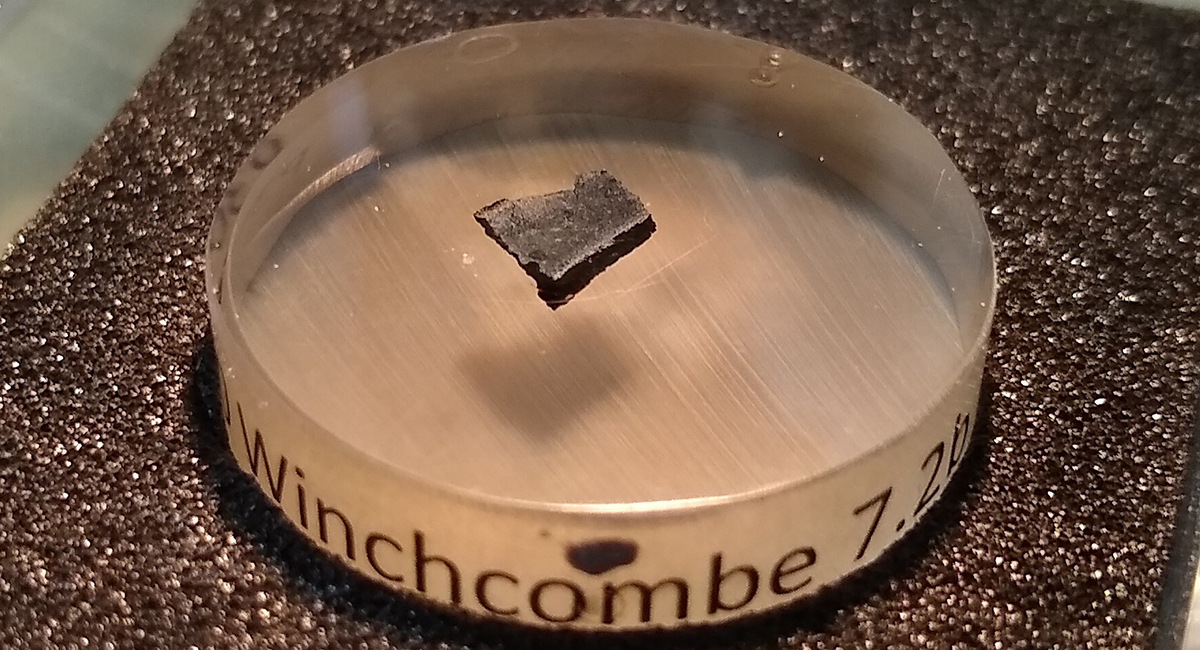
Intensive new nano-analysis of the Winchcombe meteorite has revealed how it was affected by water and repeatedly smashed apart and reassembled on the journey it took through space before landing in an English sheep field in 2021.
Cranfield University’s Dr Diane Johnson, Senior Technical Officer – Materials Characterisation, joined an international team of researchers from dozens of institutions to analyse mineral samples from the meteorite.
The research has given unparalleled insight into the history of the Winchcombe meteorite. The team’s analysis has helped roll back the clock to the meteorite’s earliest days as an ice-bearing dry rock, tracing its transformation through the melting of the ice into a ball of mud which was broken apart and rebuilt over and over again.
The Winchcombe meteorite is an unusually well-preserved example of a group of space rocks called CM carbonaceous chondrites, which were formed during the earliest periods of the Solar System. They carry minerals altered by the presence of water on their parent asteroid.
Unlike most meteorites, which can lie undiscovered for months or years after entering the Earth’s atmosphere, the Winchcombe meteorite was recovered within hours of hitting the ground. This helped prevent it from being further altered by exposure to the Earth’s atmosphere, offering scientists a rare opportunity to learn more about CM chondrites by scrutinising it down to the atomic level.
Significant finding of trace chemicals of water
Dr Johnson, who specialises in meteorite analysis , used an ion beam microscope equipt with a mass spectrometer detector (FIBSEM with TOFSIMS) at Cranfield to create microscopic 3D chemical data from a small sample of the meteorite only 1cm x 1cm. The detailed scans performed at Cranfield uncovered the trace chemistry variations of minerals formed by aqueous alteration - minerals formed and changed by the presence of water on the meteorite parent body.
“Finding trace element variations caused by the presence of water on the sample when it was part of its parent asteroid was a really significant and exciting moment,” commented Dr Johnson. “This information can tell us more about water early in the solar system, which was key to the development of life.
“With this meteorite forming far before we ever existed and even before the Earth began as a planet, the data is really valuable. It adds to our understanding of the very early solar system and will help us answer questions around the processes which formed our world.”
Eight types of rock altered by water
The team’s analysis carried out using sophisticated techniques including transmission electron microscopy, electron backscatter diffraction, time of flight secondary ion mass spectrometry and atom probe tomography, showed that the meteorite contains eight distinct types of CM chondrite rocks.
Each type of rock had been altered to different degrees by the presence of water, not just between the types of rocks but also, surprisingly, within them. The team found many examples of unaltered mineral grains next to completely altered ones, even down to the nano-scale. For comparison, a human hair is around 75,000 nanometres thick.
The team suggests that the likely explanation for the jumbled nature of the different types of rocks and their extreme variation in aqueous alteration is that the Winchcombe asteroid was repeatedly smashed into pieces by impacts with other asteroids before being pulled back together.
Meteorite more carbon-rich than previously thought
Another significant finding of the analysis is the unexpectedly high proportion of carbonate minerals like aragonite, calcite, and dolomite, along with minerals that have subsequently replaced carbonates, in the samples the team analysed.
This suggests that the Winchcombe meteorite was more carbon-rich than previously thought and likely accumulated abundant frozen CO2 before it melted to form the carbonate minerals the team observed. The team’s analysis could help explain the large carbonate veins which have been observed on the surface of the Asteroid Bennu by NASA’s OSIRIS-REx mission.
A remarkable piece of space history
The study was led by Dr Luke Daly of the University of Glasgow, who is also the lead author of the paper. Dr Daly also led the search party which recovered the largest fragment of the Winchcombe meteorite.
Dr Daly said: “If you imagine the Winchcombe meteorite as a jigsaw, what we saw in the analysis was as if each of the jigsaw pieces themselves had also been cut into smaller pieces, and then jumbled in a bag filled with fragments of seven other jigsaws.
“However, what we’ve uncovered in trying to unjumble the jigsaws through our analyses is new insight into the very fine detail of how the rock was altered by water in space. It also gives us a clearer idea of how it must have been battered by impacts and reformed again and again over the course of its lifetime since it swirled together out of the solar nebula, billions of years ago.”
Dr Johnson concluded: “Research like this helps us understand the earliest part the formation of our Solar System in a way that just isn’t possible without detailed analysis of materials that were right there in space as it happened. The Winchcombe meteorite is a remarkable piece of space history and I’m pleased to have been part of the team that has helped tell this new story.”
The publication of the paper is part of the Winchcombe science team consortium, organised by the UK Fireball Alliance and conducted by the UK Cosmochemistry Network.
The team’s paper, titled ‘Brecciation at the grain scale within the lithologies of the Winchcombe CM carbonaceous chondrite’, is published in Meteoritics and Planetary Science.
